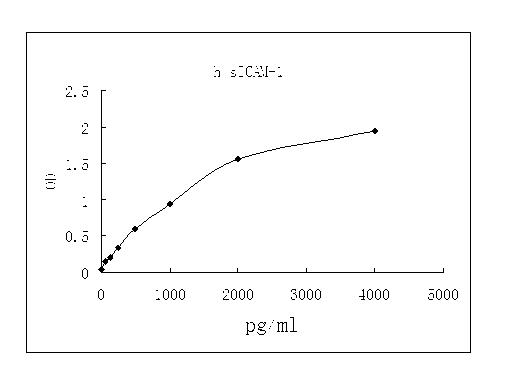Detect Range: 62.5-4000pg/ml
Sensitivity: 31pg/mL
Sample Type: Cell culture supernatant, serum, plasma (EDTA, citrate, heparin)
Sample Volume: 20 uL
Assay Time: 3 hours
Detection method: Colorimetric

Human Vascular Cell Adhesion Molecule-1 (VCAM-1) is a 100 - 110 kDa, 715 amino acid (aa) type I transmembrane glycoprotein typically characterized by the presence of seven C2-type immunoglobulin (Ig) domains (1 - 3). Its extracellular region is 674 aa in length, followed by a 22 aa transmembrane segment and a 19 aa cytoplasmic tail (1, 2). In the extracellular region, there are multiple N-linked glycosylation sites (the predicted molecular weight is 80 kDa), and each C2 domain is closed by a disulfide bridge. There is considerable interspecies VCAM-1 homology, with mouse and rat VCAM-1 showing approximately 75% aa identity to human VCAM-1 (2 - 4). Notably, the short 19 aa cytoplasmic tail is absolutely conserved, mouse to human to rat (4). Cells expressing mouse VCAM-1 bind both mouse and human leukocytes, and this reflects their high degree of aa identity (4). A number of variants of VCAM-1 are known to occur, all of which are likely the result of alternate gene splicing. In particular, a human six Ig domain molecule is known (1), and in rabbits, an eight Ig domain form has been identified (2). There is also a three-C2 domain, 43 kDa GPI-linked form of VCAM-1 (5, 6). Although it binds known VCAM-1 ligands (or co-receptors), its function is unclear. Cells known to express VCAM-1 include neurons (7), endothelial cells (8), smooth muscle cells (9), fibroblasts (10) and macrophages (11). Soluble VCAM-1 has been identified in culture supernates (12), blood (13 - 15), and cerebrospinal fluid (15, 16). In vitro, basal levels of VCAM-1 shedding by unstimulated NIH3T3 cells appear to partially require metalloproteinase activity, while PMA-induced shedding is dependent upon the proteolytic activity of TACE/ADAM17 (12).
Functionally, VCAM-1 binds to both a4b1 (VLA-4) and a4b7 (LPAM-1) integrins (17, 18). These integrins (or VCAM-1 ligands) are expressed on a variety of cells, with VLA-4 found on all leukocytes with the exception of neutrophils (17, 19, 20). Because of this, VCAM-1/VCAM-1 ligand interactions are undoubtedly key events in the rate and timing of leukocyte extravasation(3). Other roles proposed for VCAM-1 include the regulation of osteoclastogenesis via a cell-to-cell contact mechanism (22) and the induction of sickle cell adherence to vascular endothelial cells during hypoxemia (23).
Hogg, N. et al. (1991) Chem. Immunol. 50:98.
Witkowska, A.M. and M.H. Borawska (2004) Eur. Cytokine Netw. 15:91.
Staunton, D.E. et al. (1988) Cell 52:925.
Reilly, P.L. et al. (1995) J. Immunol. 155:529.
Robledo, O. et al. (2003) Eur. J. Immunol. 33:1351.
Sithu, S.D. et al. (2007) J. Biol. Chem. 282:25010.
Fiore, E. et al. (2002) Oncogene 21:5213.
Tsakadze, N.L. et al. (2006) J. Biol. Chem. 281:3157.
Jun, C.D. et al. (2001) Proc. Natl. Acad. Sci. 98:6830.
Miller, J. et al. (1995) J. Exp. Med. 182:1231.
Diamond, M.S. et al. (1990) J. Cell Biol. 111:3129.
Rosenstein, Y. et al. (1991) Nature 354:233.
Pluskota, E. and S.E. D
My Review
© 2017, AbSci All Rights Reserved. E-mail: info@abscitech.com
南京川博生物技术有限公司版权所有
苏B1-20150380 苏ICP备15009006号-1